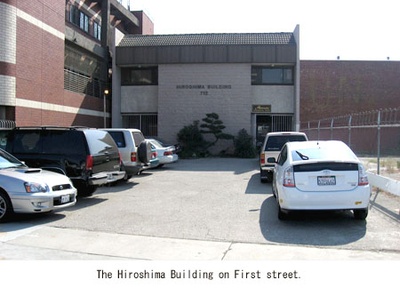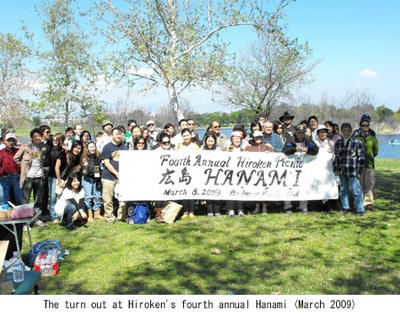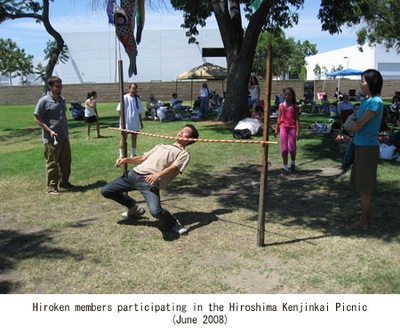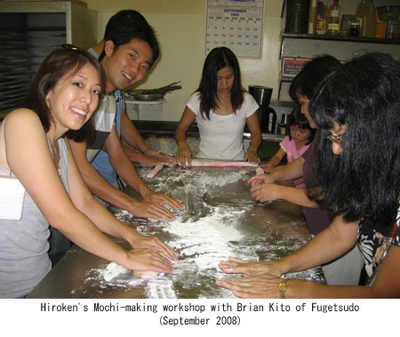My father, Tsukasa, is an Issei from Hiroshima, and came to America in 1960. So, naturally, when he arrived he became a member of Hiroshima Kenjinkai, and he has been an active member ever since. I have two brothers and a sister. As we were growing up in the '70s and '80s, my father would take us to the annual Hiroshima Kenjinkai picnic. I don’t recall much from those picnics, except that I felt like I was being dragged by my parents to go to them. (I didn’t have as much fun as Arlene seemed to have going to her Yamaguchi Kenjinai picnics.) By the time I was in high school we weren’t attending the picnics anymore, and I had little involvement with Hiroshima Kenjinkai for the next 20 years. In fact, I drifted away from all things Japanese or Japanese American until the end of my college experience (1992). That’s the year I got a teaching job on the JET program in Shimane Prefecture, just north of Hiroshima Prefecture. I spent two years working in public schools on a group of islands called the Oki Islands, which is famous for being the place where political prisoners were exiled, including two emperors.
Sometimes I too felt like I was exiled in Oki, being the only American on the islands, and hours by boat from the mainland. (Keep in mind this was before the time of the Internet and e-mailing!) But during my two years I really grew to appreciate Japanese culture, including the culture of drinking sake.
After returning to Los Angeles, I became a science teacher in the Los Angeles Unified School District at a school called Sherman Oaks Center for Enriched Studies, a magnet school in the Valley. I have now been at the school for 13 years. Teaching has been a great experience for me, but has been quite exhausting and stressful at times. Luckily I have had my Uncle Hajime around because he also appreciates sake (unlike my father).
Hajime is Tsukasa’s older brother, and he came from Hiroshima to America in the early '60s. Like Tsukasa, Hajime also became an active member of Hiroshima Kenjinkai. After I returned from Japan, Hajime and I would get together for “sake gatherings”. Together we’d enjoy sake, while I relieved my job-related stresses, and my uncle updated me on his current events. It was during these gatherings in the late '90s that I began learning of Hiroshima Kenjinkai’s declining membership. He would often mention that the membership was once in the thousands, and now it had dwindled down to a few hundred. So he would casually demand that I get involved with Hiroshima Kenjinkai to help increase that membership. He would even add that Hiroshima Kenjinkai is one of the few Kenjinkai groups that own a building, and that this building would go to the city if the organization folded. These were inspiring words, but each time I’d tell Hajime I was too busy with other things. Which was true, since I was very involved with various volunteer activities, including Yonsei Basketball Association, the JET Alumni Association, and a youth basketball team.
In 1999 my mother passed away from breast cancer. Life became very difficult to juggle so many responsibilities while grieving for my mother, so I drastically reduced my participation in my volunteer activities. Then, to step away from all that I had become involved with in LA and hopefully to gain some fresh perspective, I applied for a Fulbright Teacher Exchange Scholarship. And I was awarded one.
In January 2004, I went to South Africa to teach science in a “bush school” near the border of Mozambique – hours away from the nearest city, where the main language was Zulu, and hardly any of the natives spoke English. Yes, I was exiled again. But this time there was no sake! Actually, there was no running water and no electricity either! But we managed to make the most of our experiences. In fact, as an extra-curricular project I helped build a basketball court at my school. That year took quite a lot out of me. I went through several diseases and lost a tooth, but I can smile again knowing what we had accomplished to provide opportunities for my former and future students in that community. (By the way, I got a tooth implant since coming back to the States.)
In December 2004, I returned to LA exhausted but ready to get back into the swing of things. Hajime was now the president of Hiroshima Kenjinkai, and as soon as we started up our sake gatherings again he demanded that I get involved with Hiroshima Kenjinkai. This time he added extra pressure by saying, “If you’re going to do all that for those people in South Africa, why not do something for our people here?” He had a point, and this time I wasn’t as busy.
Hajime asked another Hiroshima Kenjinkai member, Dr. Charles Igawa, to help organize a subgroup of Hiroshima Kenjinkai. Dr. Igawa was given the contact information of all the past recipients of the Hiroshima Kenjinkai Scholarship, which consisted of more than 100 names. From that initial mailing, which emphasized the need to reverse the declining membership trend, only three showed up to the first meeting in February 2005. We brainstormed what our goals would be and how we should proceed. We met a few more times in the next few months to continue the discussion. We decided to call ourselves Hiroken, and we organized our debut event as a “yakiniku” picnic that took place on June 4, 2005 in Torrance, CA. About 50 people showed up for that event, but most were Hiroshima Kenjinkai members or friends that we had invited.
The next goal for our organizing committee was our mission statement. In a nutshell, it says Hiroken accepts anyone to be a member and welcomes people of all backgrounds to participate in our events, and Hiroken focuses on promoting events and opportunities that support Japan and the Nikkei community and its heritage. We made a point to leave out the Hiroshima part because we thought this would give us the best opportunity to attract new members. And we decided not to charge a membership fee. We figured that would help too.
For the past three years Hiroken has put on about three events per year. These events have included a presentation by a professor, movie screenings, Hanami picnics, a tour of Little Tokyo, a manju-making workshop, cherry picking, and fishing retreats. We’ve promoted our events through networking websites, like Myspace, Facebook, and Vivinavi, through e-mail lists, like the JET Alumni Association, and with ads in the Rafu Shimpo.
Hiroshima Kenjinkai kept an eye on us when we first started. Their leadership joined us for all our events and even came to all of our meetings. It took about a year before they even gave me the keys to the building. But now they trust us, and allow us to use the building without hesitation.
Interactions between Hiroshima Kenjinkai and Hiroken were minimal at first. Our events were separate and targeted different groups, so I would report to Hajime at our sake gatherings with updates about Hiroken. But Hajime, still president of Hiroshima Kenjinkai at that time, began demanding that Hiroken participate in certain Hiroshima Kenjinkai events, like the annual memorial service for deceased Hiroshima Kenjinkai members at Nishi Hongwanji Temple (incense offering), and the annual Hiroshima Kenjinkai picnic. At first it was difficult getting our committee members to participate in these additional activities, but over the years Hiroken has become more involved with Hiroshima Kenjinkai events. For example, for the past two years Hiroken has run the children’s games at the annual Hiroshima Kenjkinkai picnic, and now the Hiroshima Kenjinkai expects Hiroken to continue with that responsibility.
I think our organizing committee has done a pretty good job guiding Hiroken so far, especially since we’re all volunteers. However, Hiroken has had challenges getting our participants to get more involved. Often participants join us for one event, and they don’t come again. On top of that, only a small percentage of those participants have made the commitment to join our organizing committee. And we’ve had turn over within this core group too. But lately, there have been signs of hope. For example, more people have been coming out to join our organizing committee, and our group has now grown to 10 members! I have a feeling that part of the reason for the greater interest in Hiroken is my use of the “Hajime” technique. Yes. I’ve been telling our participants that the Hiroshima Building will one day be ours if we stick around long enough. I figured if Hajime’s words inspired me to be a part of this project, then his comments might work on others.
Looking ahead, some of the short-term challenges for Hiroken involve creating interesting and meaningful events to add to the few successful annual events we already have. We also need to work on fundraising, web presence, and other outreach. Our long-term challenge is to make Hiroken a sustainable organization with a useful role in the community capable of being the responsible steward of the Hiroshima Building and able to carry on the legacy of Hiroshima Kenjinkai. It’s a lofty goal, but I figure we have about a decade to get there and prepare for the big transition. And maybe when we get there Hajime will finally stop pressuring me with his various demands, and we can both enjoy our sake in peace. Wish us luck! And remember, if any of you out there are interested, come out and join us!
© 2009 Ken Mukai






